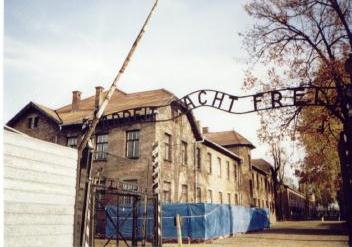 |
29 October 1999
Started early this morning and drove to Oswiecim
and Brzezinka, known by their German names as
Auschwitz and Birkenau ( Auschwitz II). Anyone
who says they did not know what was going on is
LYING. Birkenau is HUGE!!!!! MASSIVE!!! I know
that the Nazis chose Oswiecim and Brzezinka
because of their relative isolation and rail
access, but I can't believe that everything that
happened there occurred and people let it go on.
I would never have believed that it could be so
big!! And unlike Auschwitz, which was converted
Polish soldier barracks, Birkenau was basically
built by the prisoners--so this huge thing sprang
out of nowhere--and the road to Warsaw runs RIGHT
NEXT TO IT!!! Literally. I know because I had to
take it. I am sure that road ran that way 50
years ago (not much has changed since then, I
think). I guess I always knew about escaped
prisoners telling the US and Great Britain about
what was going on here, but one has to see it to
appreciate the magnitude of that knowledge. If I
ever had any doubts about NATO's sticking it's
nose where it "doesn't belong" before
(Kosovo, etc.), my mind has been permanently
changed. We have a big-ass, powerful nose, and if
we can use that "nose" to stop
genocide, we should!!!! |
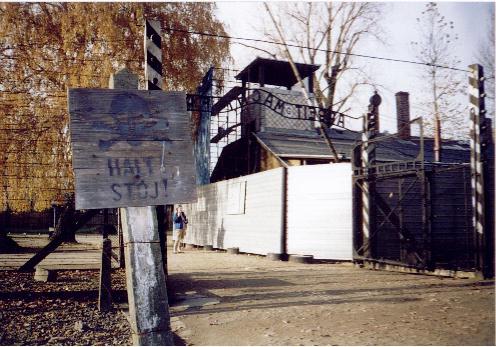 |
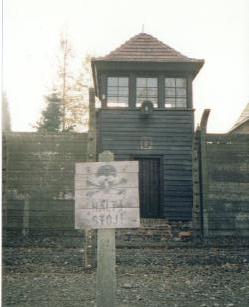
and the Red Cross didn't see this
when they "inspected"?
|

the crematorium at Auschwitz I
|
In the words of Ethan, a Canadian economist I
met walking through Birkenau, "My father
says that it is incumbent upon the strong to
protect the weak." We walked through the
camp, talking of the sheer size and how anyone
could NOT know what was going on. He was on his
way back to Krakow, so I gave him a ride to the
train station on my way to Lodz. I was very glad
to have some company, and a chance to talk about
my feelings with someone, even if he was a
complete stranger, as this was probably one of
the saddest, most horrifying, and most
emotionally draining things I have every
experienced. I don't know what I can write about
Auschwitz-Birkenau that has not been written
before, but I will try to give my impressions. My
first impression was that Oswiecim is a pretty
little town. I didn't get lost, but I had to find
an ATM machine (I know--ironic) and wanted to see
the town whose name became synonymous with evil.
The camp is only a couple of kilometers from
town, very close to the train station. I had
always imagined it to be in the countryside, even
though I knew that Polish workers and townspeople
traded with and ran messages to and for the camp
inmates. Although I have read a great deal about
Auschwitz, I did not expect it to be located so
in the "open." |
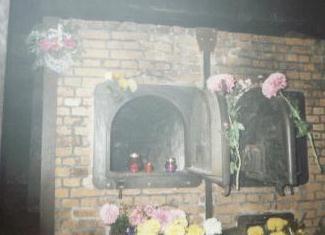
the ovens at Auschwitz I
|
|

hair and fabric made from the hair
of victims
|
|

artifical limnbs confiscated and
kept by the Nazis
|
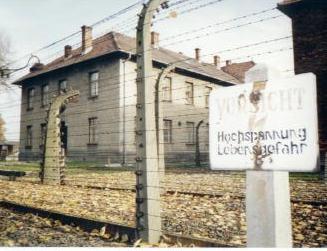
^ the electric fence that
surrounds the camp >>
|
|
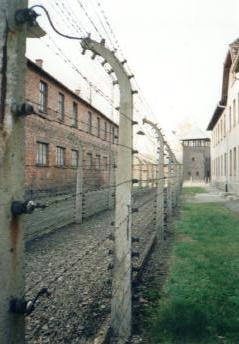
|

the starvation cell where Fr.
Maximilian Kolbe died
|

the firing wall at Block 11 |
It was quite
chilling to see the "Arbeit Macht Frei"
iron gate, with a photograph from the 1940s
showing how the orchestra would play at that
gate. Even though it was a beautiful fall day,
there was an eerie silence. Even birds did not
grace this place with song. There were not many
people there, except for a few tour groups of
high school aged students. The barracks have been
made into exhibits: the Dutch barrack, the
Italian, Hungarian, Yugoslavian, Polish, Russian,
Czechoslovak, French, etc. There was an exhibit
on what the Nazis confiscated from the
inmates--suitcases, hundreds of them,
toothbrushes and other toiletry articles,
thousands, prosthetic limbs, shoes--thousands
(and thousands more are at the US Holocaust
Museum in Washington). One room had nothing but
hair--hair that was used to make fabric (a roll
of the fabric was also on display), along with a
certificate documenting that the hair was indeed
human hair (as if anyone could deny what happened
here, although I know that revisionists try). The
crematorium was filled with candles and flowers
in memory of the victims, and the rooms still
smelled like it had been used. That smell was the
most powerful sensory experience I have known. I
felt as though I had to walk lightly and in a
straight line to keep from disturbing the spirits
who were almost palpable. Block 11 is the Death
Block--this is where the firing wall is.
Thousands of prisoners were shot here for any
minor infraction. Here in this block also are the
cellars--where Cyclon B was experimented with,
where prisoners were kept either to suffocate to
death due to poor ventilation, or their doors
were locked and they died of starvation. Fr.
Maximilian Kolbe (Saint Maximilian Kolbe)
volunteered to go to one of these locked
starvation cells so that a Polish man might live.
He died in that cell.
|
| Brzezinka, or Birkenau, as stated above, is
HUGE. The train tracks, so recognizable from Schindler's
List, run right into the camp. There is a
guard tower at the base of the camp, and if you
go to the top, you can see all of the camp, and
even seeing that cannot make you appreciate the
sheer size of this place. The train tracks run
all the way to the back of the camp, where the
gas chambers and crematoria were (prisoners
destroyed one in a revolt and the Germans tried
to blow up any evidence of their actions before
the Allies arrived--all that remains of the four
gas chambers and crematoria is mostly rubble. The
Germans also tried to liquidate the buildings of
the camp--they were not successful at destroying
all of the buildings, but for a great deal of the
camp, all that remains of the barracks are the
brick chimneys--also an eerie sight--rows and
rows of perfectly spaced chimneys as a testament
to the measured precision of the Nazis. Next to
the remains of the each of the four gas chambers,
there is a pond--and in those ponds are the ashes
of thousands who were gassed and burned. |

the train tracks to Birkenau
|
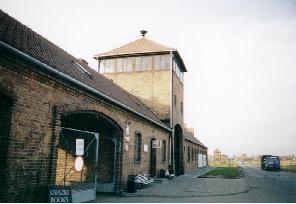
notice the main road next to the
camp?
|
|

view from the guard tower--
the camp is all you can see from the tower
|
|
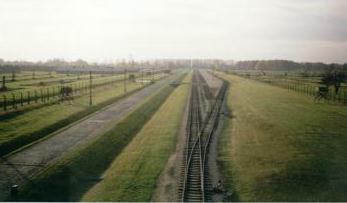
the train tracks that go through
the camp to the gas chambers--the trees on the
horizom mark the end of the camp
|

platform where the train unloaded
at the rear of the camp
|
|

stairs leading into the showers
|
|
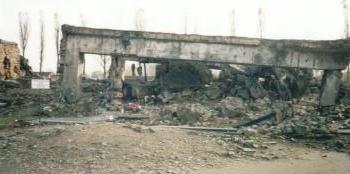
one of the four gas chambers at
Birkenau (Auschwitz II)
|
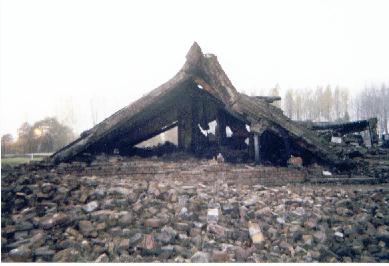
the chamber partially destroyed in
a camp revolt
|
|
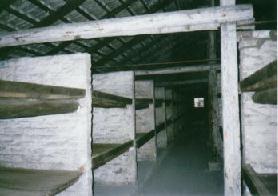
barracks in the camp
|
|
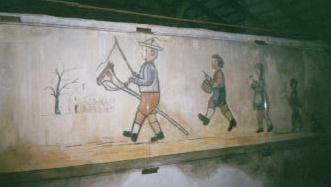
from the children's
barracks--original art
|
Left Oswiecim and drove to Lodz. A large city, I want
to stop there for a day on my way to Warsaw. I want to
visit the Jewish Cemetery, one of the largest in Europe.
2 November 1999
On my way home after the weekend, I stopped at
Auschwitz again, I wanted to be there again after
everything I had seen and read. I also wanted to
get more pictures. I knew that 2 Nov is "All
Soul's Day," but I did not expect to find
what I did at Auschwitz. I walked to Block 11,
where the firing squad wall is, and saw priests
setting up an altar there for Mass. The wall was
awash in flowers and candles. I stayed for Mass,
and even though it was in Polish, it was the most
moving Mass I have ever attended. There must have
been over a hundred people at there, children
with grandparents, families with young children,
although most of the attendees were older, and
they appeared to be mostly locals. I looked at
them, most of them crying, and wondered who they
had lost here, or who had they tried to help, or
how long they had been here themselves. On the
way home, outside of Oswiecim at approximately 4
pm, I got stopped by the police, they politely
flagged me over. I rather panicked, because I had
not been speeding, and was sure they wouldn't
speak English. The officer started speaking to
me. I said "Sorry, I do not
understand." in my poor Slovak, and he
laughed, put his hand inside my car, and pressed
the button that turns on the headlights. I was
quite relieved, to say the least. He said,
"Bye bye" and I drove off.
|
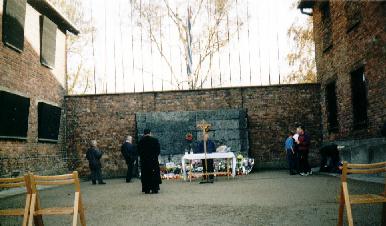
preparing for Mass at Block 11
|
|